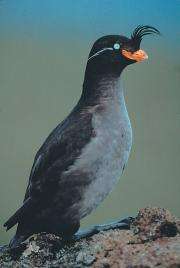February 15, 2010 report
Some birds may use their feathers to touch

(PhysOrg.com) -- A new study of auklets suggests the birds use their ornamental feathers in much the same way as cats use their whiskers: to feel their surroundings.
Male and female auklets (Aethia sp.) have elaborate and prominent whiskers or crests of feathers on their heads, and two ornithologists, Professor Ian Jones of Memorial University in St John’s, and Dr Sampath Seneviratne of the University of British Columbia in Vancouver, Canada, wondered why. There are several species of auklets, with different types of head feathers, but both genders sport the ornamental feathers.
Auklets breed in dark crevices in rocks, and the researchers made an experimental maze devoid of light and resembling a crevice, and observed the behavior of auklets placed into the maze. They found that birds with more prominent crests bump into things less than those with shorter plumes. When they flattened the feathers in whiskered and crested auklets, they found the birds were 2.5 times more likely to bump their heads than those with unflattened feathers, and the birds with longer crests were more affected than those with naturally shorter crests.
Many birds besides auklets have ornamental crests, tail feathers, beards or whiskers, and while ornamental plumage is thought to have functions in advertising sexual availability and prowess, and sometimes for camouflage or as a warning, the researchers thought they could also have a tactile function, being used by the birds to feel their way in the environment.
To find out, Jones and Seneviratne compared the ornamentation, lifestyles and habitats of numerous species of non-passerine (non-perching) birds, including penguins, parrots, hummingbirds and pheasants. Dr Seneviratne said they discovered birds living in dark, complex, or crowded environments, or which are active at night are more likely to have facial feathers, and there was a “highly significant correlation” for that trend across all non-perching birds.
The scientists think similar feathers on other birds may also have a tactile function, especially in environments where vision is limited, or where there is a greater deal of clutter or objects to avoid. Facial feathers would help the bird avoid damage to its eyes, beak, and eardrums.
The results of the study appear in the Animal Behaviour journal.
© 2010 PhysOrg.com
















